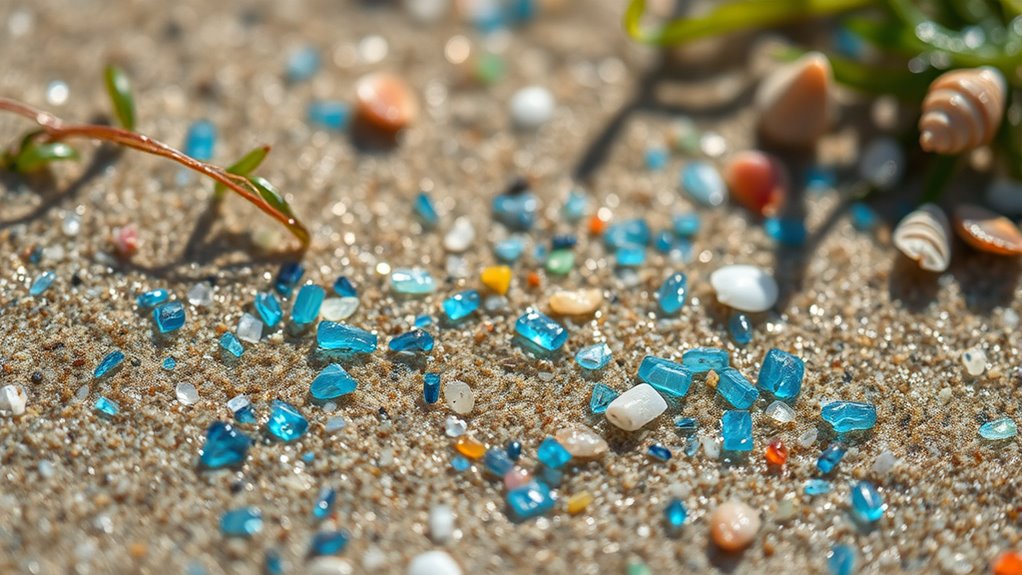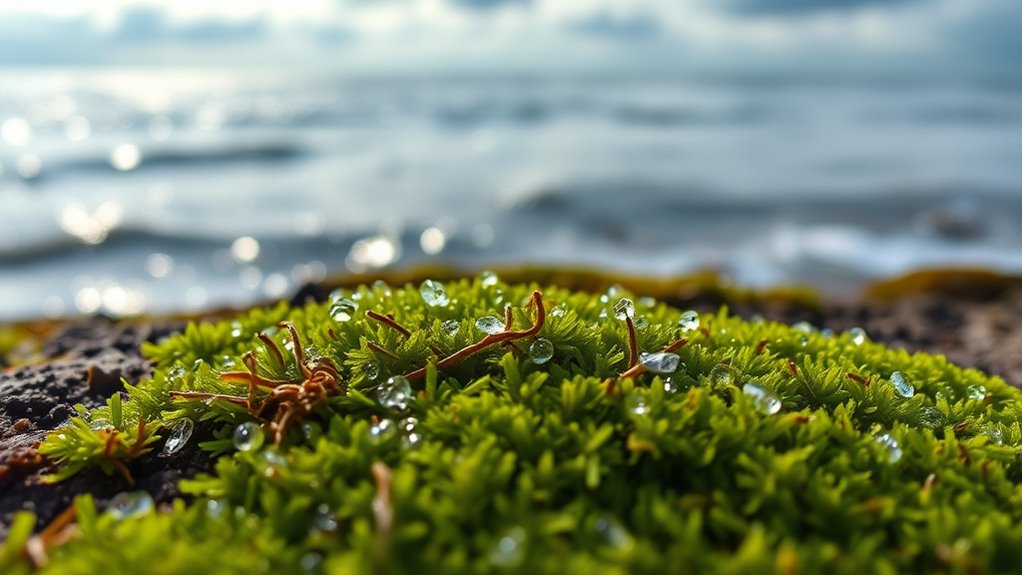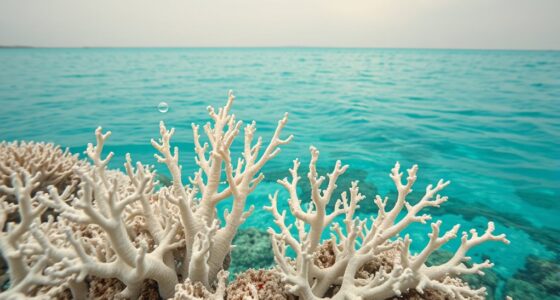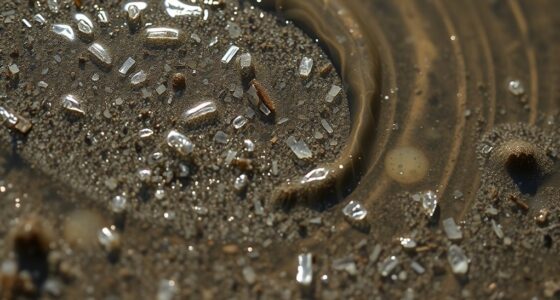Microplastics, tiny fragments under five millimeters, are infiltrating ecosystems from soil to sea, originating from waste, agricultural runoff, and littering. As they degrade slowly through sunlight and mechanical forces, they release toxic chemicals and absorb harmful pollutants, contaminating soils, waterways, and marine life. These persistent particles disrupt soil health, threaten biodiversity, and pose risks to human health. If you keep exploring, you’ll discover how this pervasive issue impacts our entire planet and what can be done about it.
Key Takeaways
- Microplastics originate from various sources like agriculture, wastewater, and litter, entering ecosystems through runoff and wind.
- They degrade slowly into tiny particles, contaminating soils and accumulating over decades, disrupting soil health.
- Microplastics can adsorb toxic chemicals and heavy metals, posing risks to soil organisms, plants, and aquatic life.
- Water and wind facilitate the migration of microplastics from soil into groundwater and oceans, spreading pollution globally.
- Long-term accumulation of microplastics threatens ecosystem integrity and human health, emphasizing the need for waste reduction.

Have you ever wondered how tiny plastic particles are infiltrating our natural environments? It’s a concerning reality that microplastics, the minuscule fragments resulting from plastic degradation, are increasingly present in soils, waterways, and oceans. When plastics break down over time—whether through exposure to sunlight, mechanical forces, or chemical processes—they fragment into these small particles, often less than five millimeters in size. This process, known as plastic degradation, accelerates the dispersal of plastics into the environment, making them difficult to detect and even harder to remove.
In soil environments, microplastics pose a significant threat by contributing to soil contamination. As plastics degrade, they release particles that settle into the soil, contaminating the land where crops are cultivated and where wildlife forages. These tiny particles can persist for decades, slowly accumulating in the soil matrix. When microplastics infiltrate the soil, they can interfere with the soil’s natural composition and harm microorganisms essential for soil health. This contamination can disrupt nutrient cycling, hinder plant growth, and even introduce toxic chemicals that are often embedded within plastics. Heavy metals and persistent organic pollutants can adsorb onto microplastic surfaces, making contaminated soils a potential source of harm to both animals and humans.
You might think that plastic waste is primarily an ocean problem, but the reality is that soil contamination is a key piece of the puzzle. Microplastics can originate from various sources—agricultural practices, wastewater sludge, or littering—and find their way into the ground. Once in the soil, they can be carried by water runoff or wind, spreading further and further. This mobility makes it difficult to contain the problem and underscores the importance of understanding plastic degradation pathways. Over time, these particles can migrate into groundwater or be transported to aquatic systems, where they become even more pervasive. Recognizing the plastic degradation process as an ongoing environmental concern emphasizes the need for sustainable practices and waste reduction initiatives.
Soil contamination from microplastics comes from various sources, spreading via water and wind, and affecting ecosystems and water systems.
The infiltration of microplastics into soil and their subsequent degradation is a slow but relentless process. Each fragment that forms from plastic breakdown adds to the growing contamination levels, which can have long-term consequences on ecosystems and human health. Recognizing how plastic degradation contributes to soil contamination helps highlight the urgency of reducing plastic waste at its source. By doing so, you help slow the infiltration of microplastics, protect soil ecosystems, and ultimately, safeguard the health of our planet.
Frequently Asked Questions
How Do Microplastics Affect Microbial Communities in Soil?
Microplastics in soil can considerably impact microbial communities by reducing microbial diversity, which weakens soil health. They may also alter soil enzyme activity, disrupting nutrient cycling and plant growth. You might notice changes in soil fertility and ecosystem resilience as microplastics interfere with the natural functions of microbes. These effects highlight the importance of understanding and managing microplastic pollution to protect soil ecosystems and maintain their essential processes.
Can Microplastics Transfer Toxins Through Food Chains?
You might wonder if microplastics transfer toxins through food chains. They can, via bioaccumulation pathways, where toxins build up in organisms over time. Trophic transfer mechanisms enable these toxins to move up the food chain as predators consume contaminated prey. This process can harm wildlife and humans, making it important to understand how microplastics contribute to toxin spread and what measures can limit their impact.
Are Certain Ecosystems More Vulnerable to Microplastic Pollution?
Imagine ecosystems as delicate tapestries, each vulnerable to unseen threads like microplastics. Urban wetlands and deep-sea vents symbolize fragile frontiers, where pollution seeps silently. These environments are especially vulnerable because their unique conditions trap or concentrate microplastics, threatening biodiversity. You must recognize that these ecosystems face heightened risks, making it essential to monitor and reduce plastic pollution to protect their intricate balance and resilience.
How Long Do Microplastics Persist in Different Environments?
You might wonder how long microplastics last in various environments. Their persistence depends on degradation rates, which vary based on environmental factors like sunlight, temperature, and microbial activity. In some settings, microplastics can remain for decades due to slow degradation, while in others, they break down faster. Understanding these factors helps you grasp how microplastics impact ecosystems over time and emphasizes the importance of reducing plastic pollution.
What Innovative Methods Are Emerging to Remove Microplastics?
You might explore innovative methods like bioremediation techniques, where microbes break down plastics naturally, or nanotechnology applications that capture microplastics efficiently. These approaches are emerging as promising solutions, offering targeted removal and environmental safety. By adopting these advanced methods, you can help reduce microplastic pollution more effectively, protecting ecosystems and human health. Stay informed about these developments to contribute to impactful environmental restoration efforts.
Conclusion
Just as Pandora’s box unleashed unforeseen troubles, microplastics now infiltrate every corner of our ecosystems, from soil to sea. You hold the power to change this course—reducing plastic use and supporting sustainable practices. Imagine a future where nature’s delicate balance is restored, like a phoenix rising from ashes. By acting now, you can help turn the tide, ensuring our planet’s story isn’t written in plastic but in renewal and hope.










